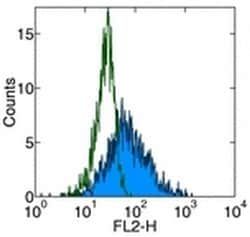CD31 (PECAM-1) Monoclonal Antibody (390), FITC, eBioscience™, Invitrogen™
Manufacturer: Fischer Scientific
Select a Size
| Pack Size | SKU | Availability | Price |
|---|---|---|---|
| Each of 1 | 50-112-8997-Each-of-1 | In Stock | ₹ 15,753.00 |
50-112-8997 - Each of 1
In Stock
Quantity
1
Base Price: ₹ 15,753.00
GST (18%): ₹ 2,835.54
Total Price: ₹ 18,588.54
Antigen
CD31 (PECAM-1)
Classification
Monoclonal
Concentration
0.5 mg/mL
Formulation
PBS with 0.09% sodium azide; pH 7.2
Gene Accession No.
Q08481
Gene Symbols
Pecam1
Purification Method
Affinity chromatography
Regulatory Status
RUO
Gene ID (Entrez)
18613
Content And Storage
4° C, store in dark, DO NOT FREEZE!
Form
Liquid
Applications
Flow Cytometry, Immunohistochemistry (Frozen)
Clone
390
Conjugate
FITC
Gene
Pecam1
Gene Alias
C85791; CD31; CD31 antigen; CD31, PECAM-1; CD31/EndoCAM; endoCAM; GPIIA'; I79_008304; PECA1; Pecam; PECAM1; Pecam-1; platelet and endothelial cell adhesion molecule 1; platelet endothelial cell adhesion molecule; platelet endothelial cell adhesion molecule-1; platelet/endothelial cell adhesion molecule (CD31 antigen); platelet/endothelial cell adhesion molecule 1; type I transmembrane endothelial adhesion molecule
Host Species
Rat
Quantity
100 μg
Primary or Secondary
Primary
Target Species
Mouse
Product Type
Antibody
Isotype
IgG2a κ
Description
- Description: The 390 monoclonal antibody reacts with mouse CD31, also known as platelet-endothelial cell adhesion molecule-1 (PECAM-1) and gpIIa
- This 130-140 kDa surface protein is expressed by endothelial cells and at low levels on all leukocytes and platelets
- It has been reported that CD38 binds to CD31
- Homotypic interaction of CD31 is important in adhesion, cell-cell and cell-matrix interaction, and signal transduction
- Applications Reported: This 390 antibody has been reported for use in flow cytometric analysis, and immunohistochemical staining of frozen tissue sections
- Applications Tested: The 390 antibody has been tested by flow cytometric analysis of mouse thymocytes and splenocytes
- This can be used at less than or equal to 1 μg per test
- A test is defined as the amount (μg) of antibody that will stain a cell sample in a final volume of 100 μL
- Cell number should be determined empirically but can range from 10^5 to 10^8 cells/test
- The 390 antibody has been tested by immunohistochemistry of frozen tissue and can be used at less than or equal to 20 μg/mL
- It is recommended that the antibody be carefully titrated for optimal performance in the assay of interest
- Excitation: 488 nm; Emission: 520 nm; Laser: Blue Laser
- Filtration: 0.2 μm post-manufacturing filtered
- CD31 (platelet endothelial cell adhesion molecule-1, PECAM-1) is an inhibitory coreceptor involved in regulation of T cell and B cell signaling by a dual immunoreceptor tyrosine-based inhibitory motif (ITIM) that upon associated kinases-mediated phosphorylation provide docking sites for protein-tyrosine phosphatases
- CD31 is expressed ubiquitously within the vascular compartment and is located mainly at junctions between adjacent cells
- N-terminal Ig-like domain of CD31 is responsible for its homophilic binding, which plays an important role in cell-cell interactions
- CD31 is a multifunctional molecule with diverse roles in modulation of integrin-mediated cell adhesion, transendothelial migration, angiogenesis, apoptosis, negative regulation of immunoreceptor signaling, autoimmunity, macrophage phagocytosis, IgE-mediated anaphylaxis and thrombosis
- It is one of key regulatory molecules in vascular system.



